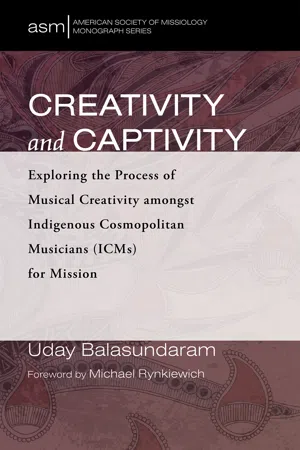![]()
1
Introduction
In the beginning, God created the heavens and the earth.
—Genesis 1:1
The God of the Jews was living, personal and creative; he was supreme Being and transcendent Act. And his claims were inescapable and paramount.
—E. L. Mascall
The greatest freedom known to humanity is found in the first few words recorded in The Holy Bible. At the same time, however, the words “In the beginning . . . ” also represent the greatest limitation imposed upon humankind. Authentic creativity is never without form or boundary. In the tradition of the “God of the Jews,” the first creative act is ascribed to a “living, personal and creative” God who reveals himself in history in Jesus Christ and is present in God’s people by the power of the Holy Spirit. Subsequently, we assume that all human creativity (being and activity) is derived from the creative being and activity of the Triune God of Christianity who is fully embodied in the church and wholly given for the world. The implication therefore is that creativity is primarily relational. It emerges and is sustained primarily in relationship with the Creator and his mission.
In this dissertation, however, it is not creativity in general that we are concerned with, but musical creativity. Here we explore the process of musical creativity amongst Christian musicians in this era of globalization as they understand and practice their creativity in the context of the mission of God.
The themes of musical creativity, the new spaces created as a result of globalizing processes, and creative mission are three main strands that together weave the process of exploration for this dissertation. The arena for exploring the process of musical creativity is the new “interstitial” spaces that emerge as a result of globalizing processes in a postcolonial environment. These new spaces form the arena for the emergence and sustenance of indigenous cosmopolitan musician (ICM) identity. The mediation of Christianity through the process of musical creativity in these new spaces for the full participation of others in the mission of God is what we refer to as creative mission. In the next section I offer a brief overview of musical creativity, new spaces, and creative mission. Before that, however, I would like to draw our attention to some initial concerns regarding music, space, and mission that we need to bear in mind as we set forth.
Problematizing Music, Space, and Mission
The “opacity” of the process of musical creativity is problematic. While there seems to be a general acknowledgment of the power of musical creativity, “how” it serves to shape and to serve the mission of the church is “anything but clear.”
Further, the perceived “amorphous” nature of the concept of creativity affects perceptions of the process of musical creativity as a system of knowledge. As a result, the ambiguity that is typically associated with the concept of musical creativity negatively impacts the full embrace of the process of musical creativity for the mission of the church. The mediation of Christianity through musical creativity is further problematized in a globalized and media-saturated culture.
In a postcolonial context it is imperative to realize that perceptions of “opacity” and “amorphous” are not blanket terms for the ways in which musical creativity as a system of knowledge is perceived and embraced in the world. Rather, these are terms that have been used to typify certain hegemonic ways of knowing over and against “other” ways of knowing. In a postcolonial world, the processes of typification often represent systems of knowledge that are “indigenous” to the West and the structures of Euro-Western thought. These methodologies of knowledge production result in the exclusion and peripherialization of the knowledge systems of the formerly colonized, marginalized, and oppressed peoples who represent the “other.”
The dilemma is intensified in that people operating in “peripheral” knowledge systems in turn are “suspicious” of the West. The implication is that the new spaces created as a result of globalizing processes are sites of continual construction, contestation, and conflict. In terms of a postcolonial paradigm, new spaces are places for a struggle to legitimize, reclaim, and create alternate ways of knowing.
The implications of the above for mission are summarized below. Here, by mission I refer to the Christian missionary enterprise located in the mission of the Triune God in redeeming, reconciling, and restoring the world to God through the Gospel. The church is called to participate in the redemptive, reconciliatory, and restorative mission of God through Jesus Christ and by the power of the Holy Spirit and thus, mission is central to the identity of the church.
First, the failure to recognize the process of musical creativity as a legitimate or authentic vehicle for carrying the weight of Christian truth undermines the effectiveness of the church when it comes to embracing the fullness of its creative and missional being. A root issue that needs to be addressed therefore is the legitimacy of musical creativity as a system of knowledge.
Relatedly, given the relational intimacy between creative being and creative activity, it follows that a devaluation of creative expression amounts to a devaluation of the creator. The separation between being and activity results in a spiritual alienation, both within the conscience of musicians—the struggle to reconcile creative expression and human identity—and in terms of their ecclesial calling. Such separation is detrimental for mission and in particular for the self-understanding and practice of musicians who see themselves as participating in the creative mission of God.
A portion of this study therefore attempts to articulate the beginnings of a theology of creativity for mission (creatio Dei) as a response to “captive” notions of authenticity derived from systems of knowledge with palpable ro...
